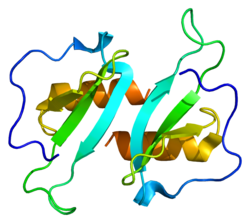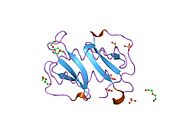CCL20
| Hemokin (C-C motiv) ligand 20 | |||||||||||
|---|---|---|---|---|---|---|---|---|---|---|---|
 PDB prikaz baziran na 1m8a. | |||||||||||
| Dostupne strukture | |||||||||||
| 1m8a, 2hci | |||||||||||
| Identifikatori | |||||||||||
| Simboli | CCL20; CKb4; LARC; MIP-3a; MIP3A; SCYA20; ST38 | ||||||||||
| Vanjski ID | OMIM: 601960 MGI: 1329031 HomoloGene: 3375 GeneCards: CCL20 Gene | ||||||||||
| |||||||||||
| Pregled RNK izražavanja | |||||||||||
 | |||||||||||
| podaci | |||||||||||
| Ortolozi | |||||||||||
| Vrsta | Čovek | Miš | |||||||||
| Entrez | 6364 | 20297 | |||||||||
| Ensembl | ENSG00000115009 | ENSMUSG00000026166 | |||||||||
| UniProt | P78556 | Q54AI7 | |||||||||
| RefSeq (mRNA) | NM_004591 | NM_016960 | |||||||||
| RefSeq (protein) | NP_004582 | NP_058656 | |||||||||
| Lokacija (UCSC) | Chr 2: 228.39 - 228.39 Mb | Chr 1: 83 - 83.01 Mb | |||||||||
| PubMed pretraga | [1] | [2] | |||||||||
CCL20, hemokin (C-C motiv) ligand 20, ili jetrenom aktivacijom regulisani hemokin (LARC), ili makrofagni inflamatorni protein-3 (MIP3A) je mali citokin iz CC hemokin familije. On je snažno hemotaksan za limfocite, a slabo provlači neutrofile.[1] CCL20 je impliciran u formiranje i funkciju mukoznog limfoidnog tkiva putem hemoatrakcije limfocita i dendritskih ćelija prema epitelnim ćelijama koje okružuju ta tkiva. CCL20 dejstvuje na svoje ciljne ćelije vezivanjem i aktiviranjem hemokinskog receptora CCR6.[2][3]
CCL20 genska ekspresija može biti indukovana mikrobnim faktorima kao što su lipopolisaharidi (LPS), i inflamatorni citokini poput faktor nekroze tumora i interferon-γ, i umanjena uticajem citokina IL-10.[4] CCL20 je izražen u više vrsta tkiva. Najobimnije izražavanje je primećeno u perifernim krvnim limfocitima, limfnim čvorovima, jetri, slepom crevu, i fetalnim plućima, a u nižim nivoima u timusu, testisima, prostati i crevima.[1][5] CCL20 gen (scya20) je lociran na hromozomu 2 kod ljudi.[6]
Reference
- ^ а б Hieshima K, Imai T, Opdenakker G, Van Damme J, Kusuda J, Tei H, Sakaki Y, Takatsuki K, Miura R, Yoshie O, Nomiyama H (1997). „Molecular cloning of a novel human CC chemokine liver and activation-regulated chemokine (LARC) expressed in liver. Chemotactic activity for lymphocytes and gene localization on chromosome 2”. J. Biol. Chem. 272 (9): 5846—53. PMID 9038201. doi:10.1074/jbc.272.9.5846.
- ^ Baba M, Imai T, Nishimura M, Kakizaki M, Takagi S, Hieshima K, Nomiyama H, Yoshie O (1997). „Identification of CCR6, the specific receptor for a novel lymphocyte-directed CC chemokine LARC”. J. Biol. Chem. 272 (23): 14893—8. PMID 9169459. doi:10.1074/jbc.272.23.14893.
- ^ Mire-Sluis, Anthony R.; Thorpe, Robin, ур. (1998). Cytokines (Handbook of Immunopharmacology). Boston: Academic Press. ISBN 0-12-498340-5.
- ^ Schutyser E, Struyf S, Menten P, Lenaerts JP, Conings R, Put W, Wuyts A, Proost P, Van Damme J (2000). „Regulated production and molecular diversity of human liver and activation-regulated chemokine/macrophage inflammatory protein-3 alpha from normal and transformed cells”. J. Immunol. 165 (8): 4470—7. PMID 11035086.
- ^ Rossi DL, Vicari AP, Franz-Bacon K, McClanahan TK, Zlotnik A (1997). „Identification through bioinformatics of two new macrophage proinflammatory human chemokines: MIP-3alpha and MIP-3beta”. J. Immunol. 158 (3): 1033—6. PMID 9013939.
- ^ Nelson RT, Boyd J, Gladue RP, Paradis T, Thomas R, Cunningham AC, Lira P, Brissette WH, Hayes L, Hames LM, Neote KS, McColl SR (2001). „Genomic organization of the CC chemokine mip-3alpha/CCL20/larc/exodus/SCYA20, showing gene structure, splice variants, and chromosome localization”. Genomics. 73 (1): 28—37. PMID 11352563. doi:10.1006/geno.2001.6482.
Literatura
- Matoba R; Okubo K; Hori N; et al. (1994). „The addition of 5'-coding information to a 3'-directed cDNA library improves analysis of gene expression.”. Gene. 146 (2): 199—207. PMID 8076819. doi:10.1016/0378-1119(94)90293-3.
- Rossi DL; Vicari AP; Franz-Bacon K; et al. (1997). „Identification through bioinformatics of two new macrophage proinflammatory human chemokines: MIP-3alpha and MIP-3beta.”. J. Immunol. 158 (3): 1033—6. PMID 9013939.
- Hieshima K; Imai T; Opdenakker G; et al. (1997). „Molecular cloning of a novel human CC chemokine liver and activation-regulated chemokine (LARC) expressed in liver. Chemotactic activity for lymphocytes and gene localization on chromosome 2.”. J. Biol. Chem. 272 (9): 5846—53. PMID 9038201. doi:10.1074/jbc.272.9.5846.
- Hromas R; Gray PW; Chantry D; et al. (1997). „Cloning and characterization of exodus, a novel beta-chemokine.”. Blood. 89 (9): 3315—22. PMID 9129037.
- Baba M; Imai T; Nishimura M; et al. (1997). „Identification of CCR6, the specific receptor for a novel lymphocyte-directed CC chemokine LARC.”. J. Biol. Chem. 272 (23): 14893—8. PMID 9169459. doi:10.1074/jbc.272.23.14893.
- Liao F; Alderson R; Su J; et al. (1997). „STRL22 is a receptor for the CC chemokine MIP-3alpha.”. Biochem. Biophys. Res. Commun. 236 (1): 212—7. PMID 9223454. doi:10.1006/bbrc.1997.6936.
- Power CA; Church DJ; Meyer A; et al. (1997). „Cloning and characterization of a specific receptor for the novel CC chemokine MIP-3alpha from lung dendritic cells.”. J. Exp. Med. 186 (6): 825—35. PMC 2199050
 . PMID 9294137. doi:10.1084/jem.186.6.825.
. PMID 9294137. doi:10.1084/jem.186.6.825. - Tanaka Y; Imai T; Baba M; et al. (1999). „Selective expression of liver and activation-regulated chemokine (LARC) in intestinal epithelium in mice and humans.”. Eur. J. Immunol. 29 (2): 633—42. PMID 10064080. doi:10.1002/(SICI)1521-4141(199902)29:02<633::AID-IMMU633>3.0.CO;2-I.
- Yang D, Howard OM, Chen Q, Oppenheim JJ (1999). „Cutting edge: immature dendritic cells generated from monocytes in the presence of TGF-beta 1 express functional C-C chemokine receptor 6.”. J. Immunol. 163 (4): 1737—41. PMID 10438902.
- Yang D; Chertov O; Bykovskaia SN; et al. (1999). „Beta-defensins: linking innate and adaptive immunity through dendritic and T cell CCR6.”. Science. 286 (5439): 525—8. PMID 10521347. doi:10.1126/science.286.5439.525.
- Charbonnier AS; Kohrgruber N; Kriehuber E; et al. (2000). „Macrophage inflammatory protein 3alpha is involved in the constitutive trafficking of epidermal langerhans cells.”. J. Exp. Med. 190 (12): 1755—68. PMC 2195721
 . PMID 10601351. doi:10.1084/jem.190.12.1755.
. PMID 10601351. doi:10.1084/jem.190.12.1755. - Schutyser E; Struyf S; Menten P; et al. (2000). „Regulated production and molecular diversity of human liver and activation-regulated chemokine/macrophage inflammatory protein-3 alpha from normal and transformed cells.”. J. Immunol. 165 (8): 4470—7. PMID 11035086.
- Hirose J; Kawashima H; Yoshie O; et al. (2001). „Versican interacts with chemokines and modulates cellular responses.”. J. Biol. Chem. 276 (7): 5228—34. PMID 11083865. doi:10.1074/jbc.M007542200.
- Nakayama T; Fujisawa R; Yamada H; et al. (2001). „Inducible expression of a CC chemokine liver- and activation-regulated chemokine (LARC)/macrophage inflammatory protein (MIP)-3 alpha/CCL20 by epidermal keratinocytes and its role in atopic dermatitis.”. Int. Immunol. 13 (1): 95—103. PMID 11133838. doi:10.1093/intimm/13.1.95.
- Nelson RT; Boyd J; Gladue RP; et al. (2001). „Genomic organization of the CC chemokine mip-3alpha/CCL20/larc/exodus/SCYA20, showing gene structure, splice variants, and chromosome localization.”. Genomics. 73 (1): 28—37. PMID 11352563. doi:10.1006/geno.2001.6482.
- Tohyama M; Shirakara Y; Yamasaki K; et al. (2001). „Differentiated keratinocytes are responsible for TNF-alpha regulated production of macrophage inflammatory protein 3alpha/CCL20, a potent chemokine for Langerhans cells.”. J. Dermatol. Sci. 27 (2): 130—9. PMID 11532377. doi:10.1016/S0923-1811(01)00127-X.
- Giannini SL; Hubert P; Doyen J; et al. (2002). „Influence of the mucosal epithelium microenvironment on Langerhans cells: implications for the development of squamous intraepithelial lesions of the cervix.”. Int. J. Cancer. 97 (5): 654—9. PMID 11807793. doi:10.1002/ijc.10084.
- Casamayor-Pallejà M; Mondière P; Verschelde C; et al. (2002). „BCR ligation reprograms B cells for migration to the T zone and B-cell follicle sequentially.”. Blood. 99 (6): 1913—21. PMID 11877260. doi:10.1182/blood.V99.6.1913.
- Schmuth M; Neyer S; Rainer C; et al. (2002). „Expression of the C-C chemokine MIP-3 alpha/CCL20 in human epidermis with impaired permeability barrier function.”. Exp. Dermatol. 11 (2): 135—42. PMID 11994140. doi:10.1034/j.1600-0625.2002.110205.x.
- Liao F; Shirakawa AK; Foley JF; et al. (2002). „Human B cells become highly responsive to macrophage-inflammatory protein-3 alpha/CC chemokine ligand-20 after cellular activation without changes in CCR6 expression or ligand binding.”. J. Immunol. 168 (10): 4871—80. PMID 11994436.
Spoljašnje veze
- CCL20 GeneCard












